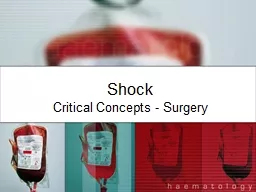

SHOCK Rude unhinging of the machinery of life Gross A momentary pause in the act of death Dr Cowley SHOCK Inadequate delivery of oxygen and nutrients necessary for normal tissue and cellular function ID: 711579
Download Presentation The PPT/PDF document "Shock Critical Concepts - Surgery" is the property of its rightful owner. Permission is granted to download and print the materials on this web site for personal, non-commercial use only, and to display it on your personal computer provided you do not modify the materials and that you retain all copyright notices contained in the materials. By downloading content from our website, you accept the terms of this agreement.
Slide1
Shock
Critical Concepts - SurgerySlide2
SHOCK
“Rude unhinging of the machinery of life”
-Gross
“A momentary pause in the act of death”
-Dr. Cowley Slide3
SHOCK
Inadequate delivery of oxygen and nutrients necessary for normal tissue and cellular function. Slide4
Types of Shock
Hypovolemic
Cardiogenic
Neurogenic (distributive)
Septic (distributive)
ObstructiveSlide5
Types of Shock
CVP
CO
SVR
other
Hypovolemic
Cold
and clammy
Cardiogenic
Neurogenic
Warm and rosySepticObstructiveClinical examSlide6
Types of Shock
Hypovolemic
Cardiogenic
Neurogenic (distributive)
Septic (distributive)
ObstructiveSlide7
How to Resuscitate
ABC’s
Choice of line?
What to use?Rate of administration?How much?When to stop?Slide8
ABCDE’s
Airway
Breathing
Tension ptx?Circulation
Tamponade
?
Disability
Neurogenic shock?
Exposure
Signs of hemorrhage/trauma?Slide9
Intravenous AccessSlide10
Intravenous Access
Hagen-
Poiseuile
LawSlide11
Which fluid?
Crystalloid
Lactated ringers
Normal SalineColloidSynthetic
Albumin
Blood
plasmaSlide12
Rate?Slide13
How much?
Class
Blood Loss
(ml)
Blood Loss
(%)
HR
BP
UOP
Mental Status
I<750<15%<100NL>30NLII750-150015-30%>100
20-30anxiousIII1500-200030-40%
>1205-15confusedIV
>2000>40%>140NonelethargicSlide14
How much?
Bolus
1 liter
Blood1:1Massive Transfusion
>10 PRBCs in 24
hrsSlide15
When to stop?
Vital signs
UOP
Base deficitLactateSlide16
HEMOSTASIS METHODSSlide17
Objectives
Review general concepts about achieving hemostasis in a bleeding subject
Discuss non-surgical compression and tourniquet methods
Discuss surgical methods using sutures, ligatures, and other devicesUnderstand the application and use of pelvic binders for pelvic fracturesSlide18
GENERAL CONCEPTS
Direct control
Be as specific (pinpoint) as possible
Avoid collateral damageInjury to tissue around point of controlDistal ischemia
Temporary versus permanentSlide19
Types of Control
Non-Surgical
Compression
TourniquetsPro-coagulant productsSurgical
Ligation
Suturing/Stapling
CauterySlide20
Non-Surgical Control- Compression
Applying direct pressure to the source o bleeding
Usually the best first step
Usually done wrongSlide21
Keys to Success
1- Pinpoint Source of Bleeding
a- Use minimal surface area
- Concentrate pressure to exact source of bleeding
b- Use minimal gauze
-
Gauze is for ABSORPTION
- Fold minimal amount of gauze into minimal size of squareSlide22
Keys to Success
2- Apply consistent pressure
A- Get into a comfortable position
B- Apply bandage/device whenever possible
Pressure DressingSlide23
Non-Surgical Control- Tourniquet
Circumferential compression cutting of blood flow to distal limb/appendage
Generally frowned upon
Only when direct pressure cannot be applied due to the nature of the injury
Amputations
Near-amputations
aSlide24
Keys to Success
Complete cessation of arterial blood flow
Non-elastic bandage
Tight enough to cause pain
Dress the open woundSlide25
Surgical Hemostasis
Bleeding Skin/Tissue Edges
Suture
StapleDressing/AdhesiveSevered vessel
Suture
Ligation
Clip
aSlide26
Bleeding Skin/Tissue Edges
Wash out wound whenever
possible
SutureSimple interruptedSimple running
Locking running
Horizontal mattress
Staple
Faster but less available
Dressing/Adhesive
Only if able to temporarily staunch the blood low